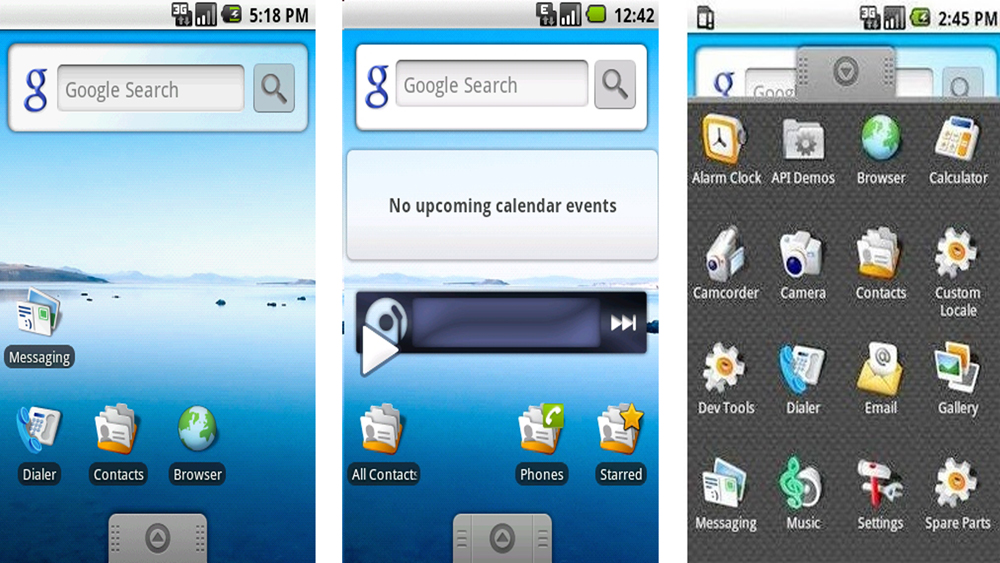INSUBCONTINENT EXCLUSIVE:
In beginning there was Cupcake2008, when pinch-to-zoom was a right reserved for iPhones and BlackBerrys were still business, a new kind of
T-Mobile G1 in US), a QWERTY keyboard-packing slider phone
policed, locked-down operating system, Android arrived with promise of open source everything
Google made access to Android Market (now called Google Play Store) freely available, and users could even customize their home screens with
widgets, offering in-app functionality from said home screen, no app opening needed.With Android 1.5, codenamed Cupcake, a new way was
a text-to-speech engine, universal search and a more complete battery usage screen, so you knew which apps were draining your smartphone
introduced Google Maps navigation, as well as additional camera modes, live wallpapers and Bluetooth 2.1 support.Android 2.2: FroyoFroyo,
aka frozen yoghurt, is confectionary number four, and Android version 2.2
Loaded up on classic phones like Samsung Galaxy S2 and HTC Incredible S, it marked point at which Android hardware started to feel more
from likes of HTC.Get some Froyo on that hotspotVersion 2.2 also introduced a feature that could make Android phones more attractive than
even another smartphone was vindication for Android fans world over.Apple would take a full year to get feature onto iPhones, with many
compared to Froyo, but it did get a host of new features, including support for new sensors, including NFC
2010 saw Google closing gap, with a long press over a word selecting just that word, and displaying a pop-up menu that included copy and
it and any version of Android we'd seen before was interface
first introduced in Honeycomb, with back, home and recent apps buttons displayed in bottom-left of home screen.Android 4.0: Ice Cream
SandwichSo long physical buttons, hello unified Android typeface!Ice Cream Sandwich was probably one of richest updates Android has seen
Available on Galaxy Nexus and HTC One X, it brought an excellent in-gallery photo editor to table, as well as a data limiter within
had been used by other smartphone manufacturers before, getting Android users comfortable with this little swipe gesture ensured its rise to
tale of three parts: 4.1, 4.2 and 4.3.4.1 was all about refinements
It took Ice Cream Sandwich and made it smoother, introduced improved support for multiple languages, and automatically resized widgets to
fit your home screen.Android 4.2 was a further refinement, this time polishing look and feel, making for an excellent-looking tablet UI,
two fingers for expanded notifications
This feature gave users a peak into details of their most recent updates
So, if your notification read '3 new tweets', a two-finger drag down would expand notification and showcase who those tweets were from, with
Android 4.4 KitKat update.'Okay Google, will this ever catch on'But it was Google Now becoming a voice assistant that blazed trail for
KitKat in October 2013, harnessing power of Google Search.It paved way for Apple's Siri, set to follow in June 2014, and two-horse mobile OS
race was about to splinter into separate smartphone and a voice assistant contests, with Google making early running.Android 5.0:
power potential, as was improved notification handling on lock screens.Setting scene for wearablesBut hidden gem within Android Lollipop was
With lower battery demands, Bluetooth LE also enabled manufacturers to create smartwatches and fitness trackers with low-capacity batteries,
Nexus 6P, these Marshmallow devices introduced USB-C ports and fingerprint scanners to Nexus line.As for software, app security was
tightened up with element-specific permissions prompting users to grant access to apps that needed to use things like their camera, phone
etc.Android 6.0 also supported MicroSD card integration into internal storage - handy for phones with under 16GB storage, though this
feature has since been removed.Doze modeFor a second time in a row, a battery saving feature is our Android highlight.If you left your
Marshmallow phone unplugged and stationary for a period of time with screen off, apps go into standby and Doze mode is activatedThis saved
battery power and cemented Android as operating system to go for if you wanted battery edge, with Android hardware packing higher capacity
batteries than iPhones, and its software optimised to take advantage of them.Android 7.0: NougatQuick app switching by double-tapping recent
more attractive, but it also borrowed something from Samsung.Split-screen multitaskingHaving introduced split-screen multitasking on its
Note line, Samsung was ahead of curve
Google lifted experience, and made it part of stock Android 7 over a year later, allowing one half of screen to be used for one app, and
granular storage control within settings.Floating videos are cool, rightBut highlight feature everybody wanted, and never ended up using
floating video window showcases a video in your UI, so you can get on with Twitter scrolling without having to stop watching your favorite
Pixel 3 XL.Loaded up with notch support, improved battery smarts and a revamped UI, complete with iPhone X-esque navigations, Android Pie is
is a suite of services available in Beta right now as part of Android P update
bit more mindfully.Additional tools range from app limiters through to a grayscale mode to give your eyes a break, as well as a wind-down
Keep checking in with TheIndianSubcontinent throughout 2019 for latest updates on Android Q, and to find out more about Pie, read our
informationgFjrUXSBhabVvAFhHcbpZV.jpg#

